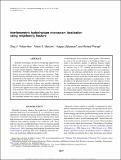Interferometric hydrofracture microseism localization using neighboring fracture
Author(s)
Poliannikov, Oleg V.; Malcolm, Alison E.; Djikpesse, Hugues; Prange, Michael
DownloadPoliannikov-2011-Interferometric hydrofracture microseism localization.pdf (1.814Mb)
PUBLISHER_POLICY
Publisher Policy
Article is made available in accordance with the publisher's policy and may be subject to US copyright law. Please refer to the publisher's site for terms of use.
Terms of use
Metadata
Show full item recordAbstract
Hydraulic fracturing is the process of injecting high-pressure fluids into a reservoir to induce fractures and thus improve reservoir productivity. Microseismic event localization is used to locate created fractures. Traditionally, events are localized individually. Available information about events already localized is not used to help estimate other source locations. Traditional localization methods yield an uncertainty that is inversely proportional to the square root of the number of receivers. However, in applications where multiple fractures are created, multiple sources in a reference fracture may provide redundant information about unknown events in subsequent fractures that can boost the signal-to-noise ratio, improving estimates of the event positions. We used sources in fractures closer to the monitoring well to help localize events further away. It is known through seismic interferometry that with a 2D array of receivers, the traveltime between two sources may be recovered from a crosscorrelogram of two common source gathers. This allowed an event in the second fracture to be localized relative to an event in the reference fracture. A difficulty became evident when receivers are located in a single monitoring well. When the receiver array is 1D, classical interferometry cannot be directly employed because the problem becomes underdetermined. In our approach, interferometry was used to partially redatum microseismic events from the second fracture onto the reference fracture so that they can be used as virtual receivers, providing additional information complementary to that provided by the physical receivers. Our error analysis showed that, in addition to the gain obtained by having multiple physical receivers, the location uncertainty is inversely proportional to the square root of the number of sources in the reference fracture. Because the number of microseism sources is usually high, the proposed method will usually result in more accurate location estimates as compared with the traditional methods.
Date issued
2011-12Department
Massachusetts Institute of Technology. Department of Earth, Atmospheric, and Planetary SciencesJournal
Geophysics
Publisher
Society of Exploration Geophysicists
Citation
Poliannikov, Oleg V. et al. “Interferometric Hydrofracture Microseism Localization Using Neighboring Fracture.” Geophysics 76.6 (2011): WC27. © 2011 Society of Exploration Geophysicists
Version: Final published version
ISSN
1070-485X
0016-8033